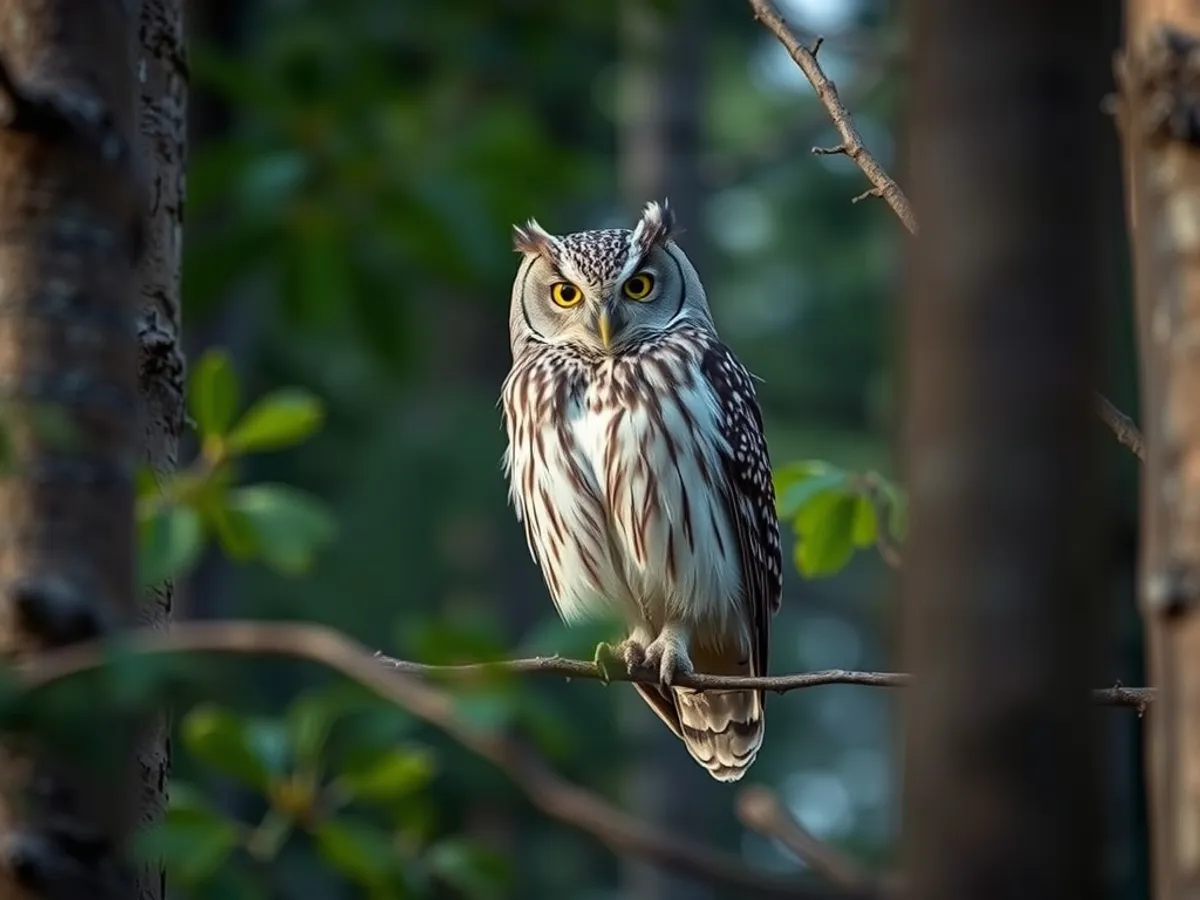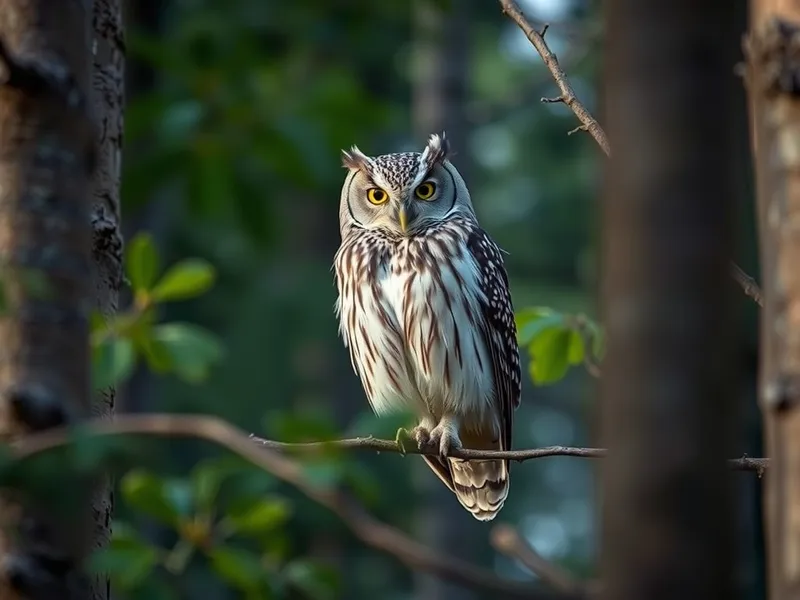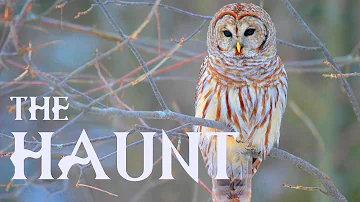
Barred Owl
Strix varia

Meet the Barred Owl
The Barred Owl is a medium to large-sized owl native to North America, easily recognized by its round head, lack of ear tufts, and distinctive brown and white striped pattern on its chest. It is known for its haunting, far-carrying call, often described as 'Who cooks for you? Who cooks for you-all?' Barred Owls prefer mature forests, especially near water, where they hunt a wide variety of small animals. These adaptable birds are mostly nocturnal but are sometimes active during the day, especially during the breeding season. While their populations are currently stable, they face threats from habitat loss and competition with other owl species.
Classification
Bird
Habitat
Mature forests, often near water bodies
Diet
Carnivore
Lifespan
8-10 years in the wild
Conservation
Least Concern
Weight
470-1050 grams
📖Fascinating Facts
Distinctive Call
The Barred Owl's call is a series of eight hoots that sound like 'Who cooks for you? Who cooks for you-all?' and can be heard over long distances at night.
Habitat Preference
Barred Owls strongly prefer mature forests with a mix of large trees and water sources such as swamps, rivers, or lakes.
Brown Eyes
Unlike most North American owls, which have yellow eyes, Barred Owls have deep brown eyes, giving them a unique appearance among their relatives.
📋Detailed Description
The Barred Owl (Strix varia) is a robust, medium-to-large owl, typically measuring 40–63 cm (16–25 in) in length with a wingspan of 96–125 cm (38–49 in), and weighing between 500–1050 grams (1.1–2.3 lbs), with females generally larger than males. Its plumage is mottled brown and white, with prominent horizontal barring on the chest and vertical streaks on the belly, providing effective camouflage against tree bark. The rounded head lacks ear tufts, and the face is characterized by a pale, disc-shaped facial ruff with dark brown concentric rings and large, dark brown eyes—unusual among North American owls, which often have yellow eyes. The beak is yellow and sharply hooked, adapted for tearing prey. Barred Owls possess powerful talons and zygodactyl feet (two toes forward, two back) for grasping prey and perching. Their flight is silent, owing to specialized feather structure that muffles sound. Primarily nocturnal, they are also crepuscular and occasionally diurnal, especially during nesting. Barred Owls are solitary outside the breeding season, but pairs maintain year-round territories. They are vocal birds, using a repertoire of calls for communication and territory defense. Their adaptability allows them to thrive in a variety of wooded habitats, including swamps, riparian forests, and even suburban parks, provided mature trees are present.
💡 Did you know?
Barred Owls can rotate their heads up to 270 degrees to better see their surroundings and hunt prey.
🔬Research & Sources
Wikipedia Summary
The barred owl, also known as the northern barred owl, striped owl or, more informally, hoot owl or eight-hooter owl, is a North American large species of owl. A member of the true owl family, Strigidae, they belong to the genus Strix, which is also the origin of the family's name under Linnaean taxonomy. Barred owls are largely native to eastern North America, but have expanded their range to the west coast of North America where they are considered invasive. Mature forests are their preferred habitat, but they can also acclimatise to various gradients of open woodlands. Their diet consists mainly of small mammals, but this species is an opportunistic predator and is known to prey upon other small vertebrates such as birds, reptiles, and amphibians, as well as a variety of invertebrates.
Last Modified: 6/2/2025
🎭Behavior & Social Structure
Barred Owls are sit-and-wait predators, typically hunting from a perch at dusk or during the night. They rely on acute hearing and vision to detect prey, often swooping silently to capture small mammals such as mice, voles, and rabbits. Their diet is highly opportunistic and may include birds, amphibians, reptiles, fish, and large invertebrates like crayfish and insects. They swallow small prey whole, later regurgitating indigestible parts as pellets. Barred Owls are territorial, with pairs defending areas of 200–800 hectares (500–2,000 acres), using vocalizations and physical displays to deter intruders. Social interactions are mostly limited to the breeding pair and their offspring, though juveniles may remain near the natal territory for several months. During the day, they roost in dense foliage, often close to tree trunks for concealment. They exhibit site fidelity, returning to favored roosts and nesting sites year after year.
👶Reproduction & Life Cycle
Barred Owls form monogamous pairs that often mate for life. Courtship begins in late winter, featuring vocal duets, mutual preening, and aerial displays. Nesting occurs from February to April, with the female selecting a natural tree cavity, abandoned hawk or squirrel nest, or occasionally artificial nest boxes. Clutch size ranges from 2–4 eggs, which are white and nearly spherical. The female incubates the eggs for 28–33 days, while the male provides food. Hatchlings are altricial, covered in white down, and remain in the nest for 4–5 weeks. Both parents feed and protect the young, which fledge at 35–40 days but may remain dependent on the adults for up to four months. Barred Owls typically raise one brood per year, though replacement clutches are possible if the first is lost.
🛡️Adaptations & Survival
Barred Owls possess several adaptations for nocturnal predation, including large, forward-facing eyes for enhanced binocular vision and depth perception in low light. Their facial disc helps funnel sound to asymmetrically placed ears, allowing precise localization of prey even under snow or leaf litter. Specialized flight feathers with serrated leading edges reduce turbulence and enable near-silent flight. Their cryptic plumage provides camouflage against tree bark, aiding in both hunting and evasion of predators. Behavioral flexibility allows them to exploit a wide range of habitats and food sources, contributing to their successful range expansion.
📚Research Sources
🎨Cultural Significance
Barred Owls are prominent in North American folklore and are often associated with wisdom, mystery, and omens due to their haunting calls and nocturnal habits. Their distinctive 'Who cooks for you? Who cooks for you-all?' call is widely recognized and referenced in regional stories and literature. In some Indigenous cultures, owls are viewed as messengers or symbols of transformation. Barred Owls have also become subjects of birdwatching and citizen science initiatives, contributing to public engagement with wildlife.
🔬Recent Research & Discoveries
Recent research has focused on the ecological impact of Barred Owl range expansion in western North America, particularly their effects on Spotted Owl populations. Studies have documented hybridization events and competitive exclusion, prompting management interventions such as targeted removals. Acoustic monitoring has advanced understanding of their vocal repertoire and territory use. Genetic studies have clarified subspecies boundaries and population structure. Ongoing research examines their adaptability to urban environments and responses to climate change, with findings suggesting continued expansion and resilience.
🎥Wildlife Videos

Haunt of the Barred Owl | Wildlife Documentary | Savvy Owls of the Boreal Forest | Canada Wild 🇨🇦
A pair of barred owls nest and raise their young owlets in an old spruce hollow deep in the heartland of Alberta. A rare, intimate ...
Canada Wild 🇨🇦

CH5 - Nature Documentary - Treasures of the Wild: Haunt of the Barred Owl
"Treasures of the Wild: Haunt of the Barred Owl" is a thrilling nature documentary that transports you to the breathtaking winter ...
EarthBound 104

An Epic Barred Owl Documentary: The Fledgling 4 Nature documentary
A FINALIST FOR THE 2024 WILDLIFE CONSERVATION FILM FESTIVAL Is spending 100 straight days with a family of owls crazy ...
Joe Gowac

Great Horned Owl on the Hunt | Nat Geo Wild
#NatGeoWILD #Owls #Birds About National Geographic Wild: National Geographic Wild is a place for all things animals and for ...
Nat Geo Animals

Wild America | S2 E7 Owls: Lords of Darkness | Full Episode HD
One of the best episodes IMO. The photography is stunning throughout with beautiful captures of owls (some of the most gorgeous ...
Wild America Animal Channel

The Owl: Master Of The Hunt (Nature Documentary) | Natural Kingdom | Real Wild
Once nature's stealth fighter focuses, its unique first strike capability allows the owl to swoop in for the kill on swift, silent wings in ...
Real Wild
🌍Habitat Information
The Barred Owl typically inhabits Mature forests, often near water bodies environments. Barred Owls have adapted to their environments with specialized features and behaviors.
Primary Habitat:
Mature forests, often near water bodies
More detailed habitat information will be available soon.
🛡️Conservation Status
The Barred Owl is currently classified as Least Concern. Conservation efforts are crucial for preserving this species for future generations.
Common Threats:
- 🏠Habitat loss and fragmentation
- 🌡️Climate change impacts
- 🎯Hunting and poaching
- 🏭Human-wildlife conflict
⚠️Threats & Conservation Challenges
While currently listed as Least Concern by the IUCN, Barred Owls face threats from habitat loss due to logging, urbanization, and wetland drainage, which reduce the availability of mature forests and nesting sites. In the Pacific Northwest, their range expansion has led to competition with the endangered Northern Spotted Owl (Strix occidentalis caurina), resulting in hybridization and displacement. Collisions with vehicles and secondary poisoning from rodenticides also pose risks. Despite these challenges, their adaptability and generalist diet have enabled stable or increasing populations across much of their range.
🔬Scientific Classification
Scientific Name
Strix varia
Classification Hierarchy
🔍 About Taxonomic Classification
Taxonomic classification is a hierarchical system used by scientists to classify and organize living organisms based on shared characteristics and evolutionary relationships.
The system moves from broad categories (Kingdom) to increasingly specific ones, with each animal's scientific name typically consisting of its Genus and species.
📝Community Notes
Share your observations and insights about the Barred Owl with our community of wildlife enthusiasts.
Join Our Community
Sign in to share your observations and connect with fellow wildlife enthusiasts.
Sign In to ContributeNo community notes yet
Be the first to share your observations about the Barred Owl!
Explore Barred Owl
Select a tab above to learn more about this amazing animal.
📸Photo Gallery
No photos available for this animal yet.
🌟Discover More Wildlife
Continue your journey of discovery with more fascinating animals from our database
